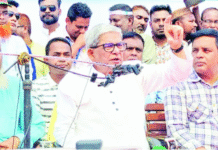The government’s claim that UNESCO has given clearance to go ahead with the Rampal coal-fired power plant project, is nowhere evident in the decisions made public by the organisation. The final report on the decisions adopted during the 41st session of the World Heritage Committee held in Poland was published on Sunday. It stated that the World Heritage Committee of the United Nations Educational, Scientific and Cultural Organisation (UNESCO) has requested that a Strategic Environmental Assessment (SEA) be carried out regarding the impact of the Rampal power project on the Sundarbans and the southwest region of the country.
The organisation has requested that no large industrial infrastructure be constructed in this region until this assessment is completed. So almost all the conditions laid down by the organisation regarding work on the Rampal power plant, remain intact. Experts say that the government’s statement to the effect that clearance has been granted to go ahead with the Rampal project is not correct.
The meeting ended on 12 July, but the full text of the decision taken at the meeting was published 18 days later. However, while the meeting was ongoing, the Bangladesh foreign ministry on 7 July issued a statement claiming that on 2 July UNESCO has withdrawn its objection to the Rampal power plant and had also decided to cancel the decision to drop the Sundarbans from the world heritage list.
Questions were raised concerning this statement of the foreign ministry. When the prime minister’s energy advisor Toufiq-e-Elahi Chowdhury returned from the meeting in Krakow, Poland, he told a press conference on 10 July that for the time being the government will not give permission for any large industrial infrastructure near the Sundarbans, but the work on the Rampal coal-based power plant would not be halted.
Decision 7 taken at the meeting stated that constant efforts would have to be made to fully implement all the other recommendations made by the 2016 Reactive Monitoring mission.
In this regard, state minister for energy, mineral resources and power Nasrul Hamid yesterday told Prothom Alo that UNESCO’s main objection had been to the Rampal power plant. In their draft decision they had called for the Rampal power plant to be shelved. But in face of Bangladesh government’s arguments and reasoning, they lifted their objection to the Rampal project. So there was no longer any obstacle to carrying out wok on the Rampal project.
However, member secretary of national committee for the protection of oil, gas, mineral resources and power and ports, Anu Muhammad, told Prothom Alo, the government made a commitment at the UNESCO meeting to accept their decision. Now if the government accepts UNESCO’s final decision, then work on Rampal must definitely be halted. And it has been proved once again that the statements made by various quarters in the government that UNESCO has withdrawn its objection to the Rampal project, are false. If the Sundarbans is to be saved, the Rampal project must be cancelled. There is no alternative to this.
Central committee member of the international organisation Water Keepers Alliance, Sharif Jamil, was present as an observer at the 41st session of UNESCO’s World Heritage Committee. Speaking to Prothom Alo, he said UNESCO had made its stand concerning the Rampal project clear in the reactive monitoring report. Over there they recommended that no industries and infrastructure, including Rampal, be set up around the Sundarbans. That means the Rampal power plant cannot be set up.
Sharif Jamil went on to say, the statement made by the prime minister’s energy advisor Toufiq-e-Elahi Chowdhury upon his return from the World Heritage Committee meeting, to the effect that UNESCO had approved of the Rampal project, was untrue and this was proven in the final decision.
In the Decision 11 of the two-page report’s section on Bangladesh, it is said that the decision taken by the Bangladesh government to carry out a strategic environmental assessment (SEA) in the Sundarbans and the southwest region must be completed as soon as possible and sent to the World Heritage Committee. After that, the World Heritage Committee will send this on to the International Union for Conservation of Nature (IUCN) for examination. Decision 11 also stated that an updated report on the state of conservation of the property and the implementation of the conditions was to be submitted by 1 December 2018 for examination by the World Heritage Committee at its 43rd session in 2019.
Source: Prothom Alo









